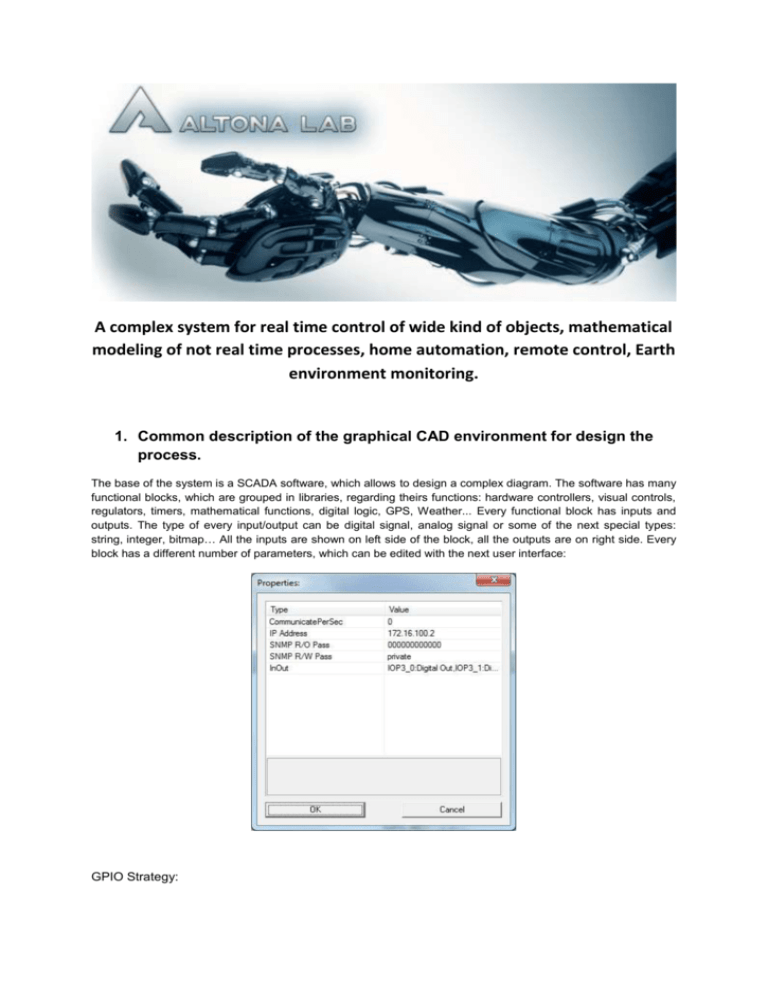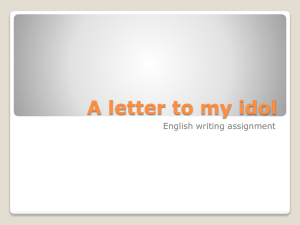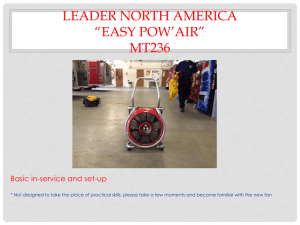AltonaLabPresentation
advertisement

A complex system for real time control of wide kind of objects, mathematical modeling of not real time processes, home automation, remote control, Earth environment monitoring. 1. Common description of the graphical CAD environment for design the process. The base of the system is a SCADA software, which allows to design a complex diagram. The software has many functional blocks, which are grouped in libraries, regarding theirs functions: hardware controllers, visual controls, regulators, timers, mathematical functions, digital logic, GPS, Weather... Every functional block has inputs and outputs. The type of every input/output can be digital signal, analog signal or some of the next special types: string, integer, bitmap… All the inputs are shown on left side of the block, all the outputs are on right side. Every block has a different number of parameters, which can be edited with the next user interface: GPIO Strategy: The product supports GPIO devices and has a user interface, which allows very easy some device’s pins to be set as digital input/output or analog input. This means that the same device’s pin can be shown on left or right side of the block and with different colors, which determines its signal type. The GPIO editor is shown below: 2. Supported working models: Process modeling. The user needs to set a discrete time and the time of the whole process. When the process is started the visualized results are not real time results. A long and complicated model can be calculated in seconds. The idea is to have the ability to model for a wide kind of real objects and to explore their behavior with different input signals and different regulators – P, PI, PID… This working model is suitable for scientific research and for the equipment for universities. Real time process control. In this case, the computer is connected via suitable hardware to a real object. The process time can be up to infinity. Some signals can be shown on computer screen at real time. Home automation. In this model, the controlled object is Home. It is easy to compose a diagram which to get decisions for switching on/off electrical devices according to a fixed time, fixed day of the week, fixed time only in workdays or holidays, at fixed temperature or any other value. (It is possible to use data from a local weather station and control the home regarding its values). The system has TCP/IP Server which allows remote control through a mobile phone. The access is password protected.. It is possible the values from the controlled processes to be visualized on the phone. Building robots. Every mobile phone with android operating system has a lot of sensors. If the phone is attached to a platform with wheels, the result will be a robot which can be controlled in real time. Information about its orientation, GPS coordinates, etc can be received. 3. An example for home automation: Several groups of blocks are available on the diagram: Controlling the bathroom fan This is the most difficult to control device at my home. The idea is as follows: every working day I leave home around 9.00h AM. A few minutes before that, I am taking a shower. If I switch on the fan, there is no one at home to switch it off after 15 minutes. The purpose of automation control is every working day (without weekend), the fan to be started at 9:05h AM and to be stopped at 9:20h AM. Additionally, I need a computer interface with buttons as sometimes I want to start or stop the fan manually. Another available option is the control of the fan remotely through an android phone. Starting the fan only at working days for period 9:05h Am .. 9:20h Am is achieved via two Blk2 blocks from the type DayOfWeek and a TimeIntervalFan block from the type TimeInterval. The output of the DayOfWeek.WorkDay block becomes at high level at all working days, the output of the TimeIntervalFan block becomes at high level at the period between 9:05;9:20 every day – this is the value of the block’s OnOffInterval parameter which is accessible with a double click over the block. The two outputs pass through an AND2 block, because both the events need to have occurred in order to start the device. Manual start from the interface’s button and through a mobile is achieved with the BlkButtonFan blocks from the type Button, output of the AndroidRemoteControl block. Out1 and Blk9 are from the type Or2. When one of the two events occurs the output of the OR block becomes at high level for a short period too. This short period is enough to start the timeout process of block Blk1 which has a TimeOutMin parameter of 15 minutes. The user can stop the fan by pressing the button represented by the BlkBtnStopFan block, which is connected with the block’s input Blk1.Stop. Both processes – starting the fan every day in the period between 9.05 and 9.20 and starting the fan manually or through a mobile device are inputs of one OR block Blk7. The result of this block controls the lamp on diagram through a BlkLampFan block and a relay on pin 3 of the UMP2Outputs block. The same result is connected with a digital input In7 of block AndroidRemoteControl, the purpose of which is to show on the phone screen the status of the fan. Parameter NameInput7 of the same block is set to text ‘FanBathroom’. If the fan is started, on the phone screen the user will see FanBathroom:On, when it is stopped the user will see FanBathroom:Off. Controlling an electrical boiler. This device is controlled easy, the block BoilerTimerNight from type TimeInterval has a parameter OnOffInterval with value: 2:50;5:40&17:50;18:10, which means that there are two time intervals in which the output of the block will have high level. The first interval is at night in the period between 2.50 AM and 5.40 AM, when the boiler works only with night low cost energy. The second period is between 17.50 PM and 18.10 PM, the time before my family is back at home. These two periods guarantee enough hot water at my home. The output of the TimeInterval block is an input to the lamp block BlkLampBoiler and pin 1 of the block UMP2Outputs which controls the relay. The relay controls the electrical boiler. Controlling a bathroom’s heater The device can be controlled through a mobile phone. For this purpose the output Out3 of block AndroidRemoteControl is connected with Start input of the Blk13 block from the type TimeOut. The timeout period is set to 15 min and when the button for heater in the android application is pressed, the lamp connected to the BlkLampHeatBath block will flash for 15 min and the same signal will switch on the relay connected to pin In2 of block UMP2Outputs for the same period. The user can stop the heater before the 15 min period has expired via the button connected to the BlkBtnStopHeatBath block. This button is on the left side of the diagram and has a caption Stop Bath Heater. The output of TimeOut is connected with In9 digital input of block AndroidRemoveControl. As the parameter of block AndroidRemoteControl is set to ‘HeaterBath’ when the heater is started, the user will see a text on mobile screen which reads HeaterBath:On, when the heater is stopped - the text on the mobile screen will be HeaterBath:Off. Receiving information about the outside air temperature Outputs of the block WeatherInfo with parameter ObjectID=1 have values equal to current weather values in the nearby areas around my home. The output Temp of the same block is connected with an In1 of block AndroidRemoveContol and with a block BlkTempVarna. The actual temperature is shown on diagram above the WeatherInfo block in red color. The same value will be shown on the mobile phone with a text “TempVarna” because this is the value of parameter NameInput1 of block AndroidRemoteControl. Controlling outdoor lightning The perfect block for this purpose is SunInfo. Latitude and Longitude parameters of this block have to be set and the output IsNightTwilight will get high value when the night twilight begins and will gets low value when the morning twilight ends. Its output controls the diagram lamp connected to the BlkLampYard block, input In4 of block UMP2Outputs and will it status will be shown on the mobile phone with the text “YardLamp” – as this is the value of the NameInput8 parameter of the AndroidRemoteControl block. Output Out2 of block AndroidRemoteControl can start TimeOut block for 1 minutes, this is another way to switch on the lightning from mobile device. 4. Android application for remote control: The android application allows mobile device to be connected remotely via TCP/IP internet protocol to computer with SCADA software and to monitoring and control a wide range of processes and devices. The communication is protected with password. One SCADA process can supports many mobile devices with remote control application with different passwords. This allows one mobile device to control one part of the process, other mobile device to control other part of the process. The application has two windows - working window and window for settings. All the documentation for AltonaLab SCADA software is published at: http://bgtimes.com/scada/index.php/en/ 5. Monitoring Earth environment. The system has a few basic parts: 5.1 Monitoring station - the place, where the Earth environment will be monitoring, have to be equipped with computer (laptop), small UPS and a set of devices according needful environment values, which will be measured: - Weather station to monitoring air temperature, humidity, wind speed and wind direction, wind child, air pressure; - Gaiger counter to monitoring background radiation; - 5 temperature sensors with SNMP TCP/IP controller to monitoring soil temperature at depth 2sm, 5sm, 10sm, 20sm, 100sm; - 3 dimensions acceleration sensor to monitoring Earth quakes; - 3 dimensions magnetic sensors or mobile phone with the same sensors to monitoring Earth magnetic field; On the computer works AltonaLab SCADA software, which reads the data from controllers and sensors and saves it in a local database. On every 5 minutes, the software tries to establish connection to FTP Server. If there is not communication problem, the local data will be sent to FTP server and will be deleted from local database. This communication way prevents data lost in case of missing internet access. The system allows unlimited number of monitoring stations all over the world to be connected to central Server. 5.2 Central Server. The machine works permanently. It communicates with FTP server (which can works on the same server or can be used other FTP server from hosting provider). Per every 3 minutes, a special software gets all the data from FTP server from all monitoring stations and imports it to SQL database. In case of registered Earth quake, the data from the quake which is around 100 measured dots per seconds are imported to SQL database and the graphic of quake is shown on the WEB page of the monitoring station. Per every 10 minutes, other software draws weekly graphics for every monitoring station and for every measured values and upload the graphics to FTP server, where they are ready to be shown in WEB. Every Monitoring station has theirs own WEB page. At the end of every day, the same software draws many other graphic reports for longest periods – three months, annual reports, statistics. The system allows at one graphic to be shown data from many monitoring stations, for example we can see the air pressure changes from few stations, which will bring us information for moving air front. 5.3 Examples of measured weather data: The weather in Varna, Bulgaria, weekly report, it is generated per every 10 minutes: http://bgtimes.com/weather/Weather_files/WeatherWeekOut.jpg Wind rose in Varna, Bulgaria, generated per every 10 minutes, 2 hours per rose: http://bgtimes.com/weather/Weather_files/Wind24h.jpg The weather in Varna, Bulgaria, annual report, it is generated per every 24 hours: http://bgtimes.com/weather/Weather_files/WeatherAnnualOut.jpg Anomaly in background radiation, registered after rain in Varna, Bulgaria at 24.11.2013: http://bgtimes.com/weather/RadiationAnomaly20013_11_24.jpg Soil temperature in Varna, Bulgaria, weekly report, it is generated per every 10 minutes. Depth of the sensors are: 2 sm, 5 sm, 10 sm, 20 sm, 90 sm. Additional the air temperature from the weather station is shown too on the same graphic: http://bgtimes.com/weather/Weather_files/SoilWeek.jpg Registered Earth quake in Varna, Bulgaria at 06.10.2013, 4.37h. The epicenter is in Vrancha, Rumania. The used sensor is Onavi and is bought from Stanford university in USA: http://bgtimes.com/weather/QuakeVrancha06102013_0437.jpg 5.4 Additional possibilities: - Every monitoring station can be equipped with WEB camera and a frame from it to be send per few minutes to central server. The local weather can be visible from central office or via WEB interface. If around the station there is a special object, which is needed to be monitoring, like lake level, waves in sea or something else, the WEB camera can be directed toward this object. - Monitoring the water temperature in lakes, seas, oceans and theirs levels. - Remote control from central office of the all monitoring stations – start/stop yard lighting or some other executive devices. 5.5 Statistics: Using OLAP database technology, a great reporting system allows many statistical reports: - Average, minimal, maximal values over data extracted for daily, monthly and annual time period. Extremums – the maximum change of some value for a short period of time.







